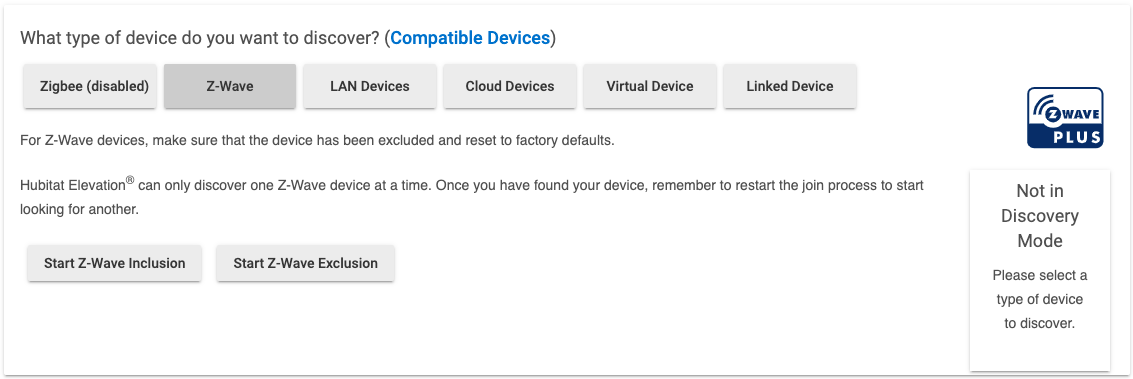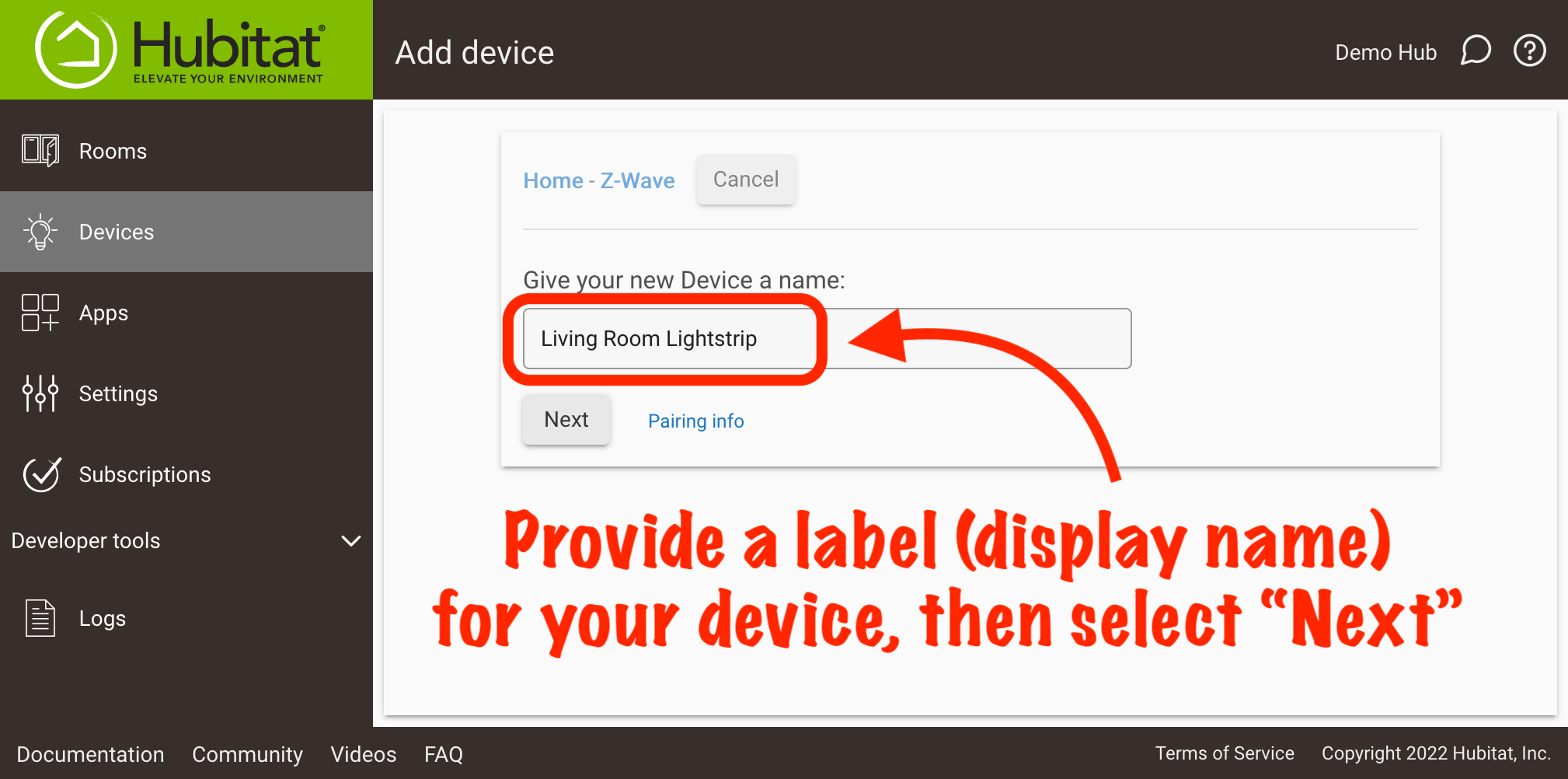Difference between revisions of "Add Device"
(Updated for new 2.2.9 (?) UI) (Tag: Visual edit) |
|||
| Line 1: | Line 1: | ||
{{Top}} | {{Top}} | ||
| − | <big>Discovering Devices is the process for pairing your Zigbee and Z-Wave mesh devices. Other devices, such as [[Lutron Integration|Lutron]] and [[Hue Bridge Integration|Philips Hue Bridge]], are connected using integration apps which can be found in the Apps | + | <big>Discovering Devices is the process for pairing your Zigbee and Z-Wave mesh devices. Other devices, such as [[Lutron Integration|Lutron]] and [[Hue Bridge Integration|Philips Hue Bridge]], are connected using integration apps, which can be found in the '''Apps''' menu item. Remember that as you connect Zigbee and Z-Wave devices, they will have a limited range, and if they are too far from your hub, you will need to add repeating devices (devices that plug in to the wall or are AC/mains-powered) to make the connection.</big> |
| − | <big>Here's how to | + | === '''<big>How to Discover Your Devices</big>''' === |
| + | <big>Here's how to add new Zigbee or Z-Wave devices:</big> | ||
| − | #<big> | + | # <big>Choose the '''Devices''' menu item from the sidebar, then choose the '''Add Devices''' button in the upper right.</big> |
| − | #<big>Choose | + | # <big>Choose '''Find by device type''' (to see compatible devices sorted by type, like dimmer or motion sensor) or '''Find by brand''' (to see compatible devices sorted by manufacturer/brand), then continue following the prompts to find your specific device.</big> |
| − | #<big> | + | #* <big>Pairing instructions will appear on this page for most compatible devices. Consult your device manual if available, as instructions may vary slightly between hardware or firmware revisions of similar devices.</big> |
| + | # <big>''Alternatively'', choose one of the buttons under "Add a device manually" according the appropriate protocol: '''Z-Wave''', '''Zigbee''', '''Iris V1 Zigbee''' (note: ''not'' for Iris v2 or later), or '''Virtual'''.</big> | ||
| + | # <big>Put your device in paring mode (if not virtual), according to the device-specific instructions presented above or the ones included with your device, and follow the prompts.</big> | ||
| − | <big>For | + | <big>For Zigbee devices, the hub will present a '''Start Pairing''' button after you press one of the two Zigbee type buttons, which will put the hub in pairing mode for 60 seconds. You can stop it at any time by pressing the button, now '''Stop Pairing''', again. You may pair more than one Zigbee device at a time, but you may prefer to do them one at a time for easier identification.</big> |
| − | <big>For Z-Wave Devices, you have two button options: '''Start Z-Wave Inclusion''' (join your device to the Z-Wave radio) or '''Start Z-Wave Exclusion''' (remove | + | <big>For Z-Wave Devices, you have two button options: '''Start Z-Wave Inclusion''' (join your device to the Z-Wave radio) or '''Start Z-Wave Exclusion''' (remove a device from the Z-Wave radio). You can '''Start Z-Wave Pairing''' and this will put the hub into "Inclusion Mode" for 100 seconds. You may pair only one Z-Wave device at a time.</big>[[File:Start Z-Wave Inclusion or Exclusion 3.0.png|none|thumb|600x600px|alt=Pressing the Zigbee button, or the Iris version one Zigbee button will present a "Start Pairing" button. Pressing the Z-Wave button will present two buttons. One button for Inclusion, to join your Z-Wave device to the hub's Z-Wave radio, and a button for Exclusion, to remove your Z-Wave device from the hub's Z-Wave radio.]] |
| − | [[File:Start Z-Wave Inclusion or Exclusion 3.0.png|none|thumb|600x600px|alt=Pressing the Zigbee button, or the Iris version one Zigbee button will present a "Start Pairing" button. Pressing the Z-Wave button will present two buttons. One button for Inclusion, to join your Z-Wave device to the hub's Z-Wave radio, and a button for Exclusion, to remove your Z-Wave device from the hub's Z-Wave radio.]] | ||
<big>You can '''Start Z-Wave Pairing''' and this will put the hub into "Inclusion Mode" for 60 seconds. However, it is good practice to Exclude a Z-Wave device before trying to add it to Hubitat Elevation. After each Z-Wave device is found, you need to start Z-Wave pairing again.</big> | <big>You can '''Start Z-Wave Pairing''' and this will put the hub into "Inclusion Mode" for 60 seconds. However, it is good practice to Exclude a Z-Wave device before trying to add it to Hubitat Elevation. After each Z-Wave device is found, you need to start Z-Wave pairing again.</big> | ||
===<big>To Exclude a Z-Wave Device:</big>=== | ===<big>To Exclude a Z-Wave Device:</big>=== | ||
| − | <big> | + | <big>If you have a Z-Wave device that will not pair or was previously joined to and not removed/excluded from a previous network, try a general Z-Wave exclusion first. You may also need to try this if a previous attempt at pairing the device to your hub failed.</big> |
| + | |||
| + | <big>To do this, the '''Start Z-Wave Exclusion''' button. Press the appropriate button or button combination on the device (see manufacturer's instructions) and you should see a message "Unknown Z-Wave Device was excluded". This means this device no longer is associated with a previous Z-Wave network and can now be paired with Hubitat Elevation.</big> | ||
[[File:Start Z-Wave Exclusion 3.0.png|none|thumb|600x600px|alt=When you press the "Start Z-Wave exclusion" button, the hub will enter exclusion mode for 30 seconds]] | [[File:Start Z-Wave Exclusion 3.0.png|none|thumb|600x600px|alt=When you press the "Start Z-Wave exclusion" button, the hub will enter exclusion mode for 30 seconds]] | ||
[[File:Z-Wave device Excluded 3.0.png|none|thumb|600x600px|alt=When Exclusion has successfully completed, the hub will display the message, Unknown Z-Wave device excluded]] | [[File:Z-Wave device Excluded 3.0.png|none|thumb|600x600px|alt=When Exclusion has successfully completed, the hub will display the message, Unknown Z-Wave device excluded]] | ||
===<big>Naming a Device</big>=== | ===<big>Naming a Device</big>=== | ||
| − | <big>After the hub discovers your device, you can give it a "Label" or a friendly name that you can use to identify the device.</big> | + | <big>After the hub discovers your device, you can give it a "Label" or a friendly name that you can use to identify the device. This how it will appear in apps (and logs), and it will also be used as the most prominent name on the '''Devices''' page if provided.</big> |
[[File:Found device.png|none|thumb|link=https://docs.hubitat.com/images/f/f6/Found_device.png|430x430px|alt=Immediately after joining a device to the hub, you can enter what you would like it to be called in a device label field. If you don't enter it here, you can always enter or change it from the device details page.]] | [[File:Found device.png|none|thumb|link=https://docs.hubitat.com/images/f/f6/Found_device.png|430x430px|alt=Immediately after joining a device to the hub, you can enter what you would like it to be called in a device label field. If you don't enter it here, you can always enter or change it from the device details page.]] | ||
Revision as of 05:14, 22 February 2022
Discovering Devices is the process for pairing your Zigbee and Z-Wave mesh devices. Other devices, such as Lutron and Philips Hue Bridge, are connected using integration apps, which can be found in the Apps menu item. Remember that as you connect Zigbee and Z-Wave devices, they will have a limited range, and if they are too far from your hub, you will need to add repeating devices (devices that plug in to the wall or are AC/mains-powered) to make the connection.
Contents
How to Discover Your Devices
Here's how to add new Zigbee or Z-Wave devices:
- Choose the Devices menu item from the sidebar, then choose the Add Devices button in the upper right.
- Choose Find by device type (to see compatible devices sorted by type, like dimmer or motion sensor) or Find by brand (to see compatible devices sorted by manufacturer/brand), then continue following the prompts to find your specific device.
- Pairing instructions will appear on this page for most compatible devices. Consult your device manual if available, as instructions may vary slightly between hardware or firmware revisions of similar devices.
- Alternatively, choose one of the buttons under "Add a device manually" according the appropriate protocol: Z-Wave, Zigbee, Iris V1 Zigbee (note: not for Iris v2 or later), or Virtual.
- Put your device in paring mode (if not virtual), according to the device-specific instructions presented above or the ones included with your device, and follow the prompts.
For Zigbee devices, the hub will present a Start Pairing button after you press one of the two Zigbee type buttons, which will put the hub in pairing mode for 60 seconds. You can stop it at any time by pressing the button, now Stop Pairing, again. You may pair more than one Zigbee device at a time, but you may prefer to do them one at a time for easier identification.
For Z-Wave Devices, you have two button options: Start Z-Wave Inclusion (join your device to the Z-Wave radio) or Start Z-Wave Exclusion (remove a device from the Z-Wave radio). You can Start Z-Wave Pairing and this will put the hub into "Inclusion Mode" for 100 seconds. You may pair only one Z-Wave device at a time.
You can Start Z-Wave Pairing and this will put the hub into "Inclusion Mode" for 60 seconds. However, it is good practice to Exclude a Z-Wave device before trying to add it to Hubitat Elevation. After each Z-Wave device is found, you need to start Z-Wave pairing again.
To Exclude a Z-Wave Device:
If you have a Z-Wave device that will not pair or was previously joined to and not removed/excluded from a previous network, try a general Z-Wave exclusion first. You may also need to try this if a previous attempt at pairing the device to your hub failed.
To do this, the Start Z-Wave Exclusion button. Press the appropriate button or button combination on the device (see manufacturer's instructions) and you should see a message "Unknown Z-Wave Device was excluded". This means this device no longer is associated with a previous Z-Wave network and can now be paired with Hubitat Elevation.
Naming a Device
After the hub discovers your device, you can give it a "Label" or a friendly name that you can use to identify the device. This how it will appear in apps (and logs), and it will also be used as the most prominent name on the Devices page if provided.
TROUBLESHOOTING
If your device does not pair, here are some potential culprits:
- Is your device compatible? Hubitat Elevation includes Z-Wave™ and Zigbee radios that work with a wide variety of Zigbee and Z-Wave devices. Check this list of known compatible devices. Devices running on different protocols, such as Lutron and Philips Hue Bridge, require a bridge that must be paired using an integration app. Lutron and the Hue Bridge have discovery processes their own. The Lutron and Hue bridges are not added to Hubitat Elevation via the discovery process.
- Is your device out of range? Z-wave and Zigbee radios have a limited range that is further reduced by obstructions, included metal, wood, concrete, plaster and drywall. It is important to build out a mesh network that includes plugged-in or AC mains powered devices that act as repeaters and boost the range and signal strength of your hub. Battery operated devices do not function as signal repeaters. Note: You should not use Zigbee lightbulbs to repeat signals, since their performance for that task is poor among anything but another lightbulb, which will result in an unstable Zigbee radio mesh for your other Zigbee devices. See the How to Build a Solid Zigbee Mesh and How to Build a Solid Z-Wave Mesh documents for further details.
- Is this a Z-Wave device from another hub? Unless it is a new device, Z-Wave devices must be excluded from their previous hub before they can be joined with a new hub. Ideally you should perform a device exclusion and a factory reset before attempting to join it to the new Z-Wave network. If the procedure to factory reset is not available, then you should at least perform device exclusion. To do this, go the Settings in the hub user interface and choose Z-Wave Details. Choose Z-Wave Exclude and follow the manufacturer instructions that were included with you Z-Wave device.
- Is your device in pairing mode? All devices are different. Check the device manual to make you have followed the proper procedure to put it in pairing mode.
- Did your Z-Wave device fail to be included properly? Run a general Z-Wave Exclusion (see Step 3 above), then try joining it again.
- Is the device battery dead? Try pairing with a fresh battery.
- Are there Zigbee bulbs interfering? Certain Zigbee bulbs may interfere with the routing of the Zigbee network traffic. If you're having trouble with Zigbee device discovery, try temporarily removing nearby bulbs to see if this alleviates the issue. Be sure to add AC powered Zigbee repeaters. Do not rely on Zigbee lightbulbs to repeat signals, since their performance for that task is poor among anything but another lightbulb, which will result in an unstable Zigbee radio mesh for your other Zigbee devices. Sengled is the only known manufacturer that make Zigbee lightbulbs which do not attempt to repeat signals to other devices. Therefor they are the only known Zigbee smart bulbs that do not require special attention. See the How to Build a Solid Zigbee Mesh and How to Build a Solid Z-Wave Mesh documents for further details.




